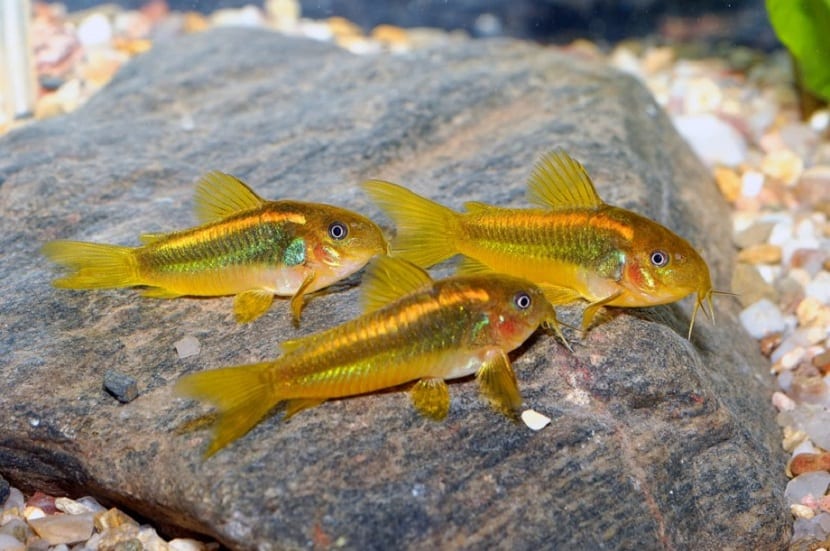
Do you know the fish Corydoras? For any hobbyist who starts with his first aquarium, it is vitally important that he knows some main species that he must introduce in it that fulfill functions such as cleaning funds or cleaning the glass.
The species that is responsible for cleaning the bottom of the aquarium and that we are going to talk about today is Corydora. The word Corydoras comes from greek kory ('helmet') and dora ('skin'). This is justified by the lack of scales and the presence of bony shields along the body. These species are normally acquired by the advice of the merchant who sells you the aquarium and tells you that there are fish in charge of cleaning the aquarium bottoms and cleaning the glass. Do you want to know everything about this fish?
Classification and geographical distribution
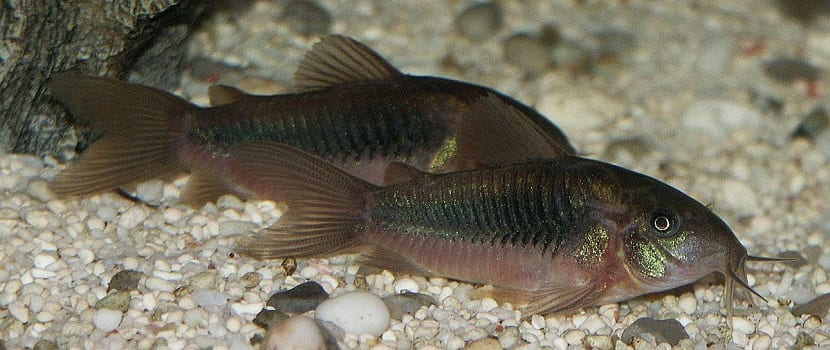
Inside to the family callichthydae two subfamilies coexist: callichthyinae y coridoradinae. Within them there are several Genres, of which the best known are: Aspidoras, Brochis, Callichthys, Corydoras, Dianema and Hoplosternum.
The corydoras also have, in turn, more than 115 classified species and another 30 unclassified. These species belong to the South American areas and Neotropical areas. They extend from La Plata (Argentina) to the extreme north of Venezuela in the Orinoco River basin.
There are species of corydoras that have developed a great capacity to adapt to environments, both colder and warmer, and they cover almost all South American latitudes. For example, the corydora aeneus it is distributed by almost all the latitudes of South America.
They generally inhabit clean waters, with rather slow currents and preferably with a sandy bottom, where their work in search of food is facilitated. As for the range of temperatures that they endure, it is quite wide. Some species can withstand 16 ° C and others up to 28 ° C.
Fish clean background

When you buy a bottom clean fish, we think we can forget to clean our fish tank. That is the first mistake. A bottom cleaning fish does not clean as well as it should, since it ends competing with the other fish by the scales that float on the surface.
The good thing about these fish is that the rest of the time they spend there they are stirring with their chins the floor of the aquarium in search of food. This helps in cleaning the bottom, but this animal does not feed on the "garbage" of the rest de peces nor is he a garbage collector. Simply, the fact of being looking for food makes it clean the bottom of the aquarium and keep it more stable.
Adaptation and salinity
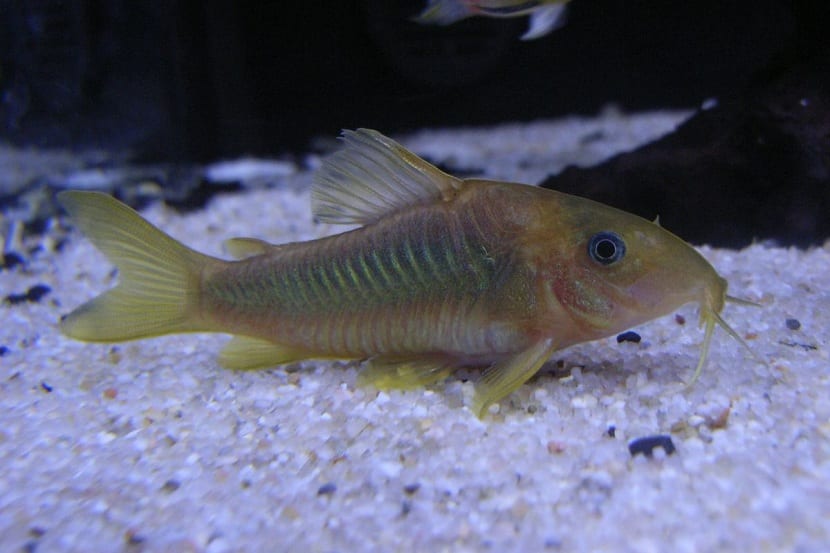
Many corydoras show signs of their own evolution and adaptation to the environment where they live. Mechanisms that help you survive. For example, the species that inhabit sandy bottoms have their dorsal region patterned with patches of various kinds. This makes, seen from above, they can be confused with the background and avoid being captured by predators. Those that inhabit dark or silty beds have a brown or dark back for the same reason. Chromatic variations within oneself are also due to adaptation to the environment.
As for the type of water that corydora prefers, we find sweet and slightly salty ones. It is more common to find corydoras in fresh waters such as lagoons. Although in many places it is said that corydoras do not tolerate salt, that is not always true. Only some species that come from tropical waters of the Amazon are more uncomfortable in the presence of salt in the water. However, this salt is not a reason to cause the death of the fish, far from it.
Habits
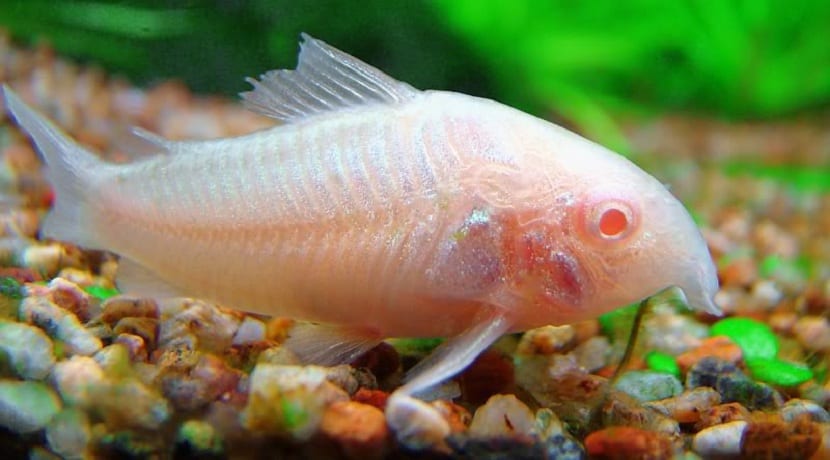
Being used to bottoms, corydoras are poor swimmers. Its physical form responds to the habit it is used to: moving along the bottom of rivers in search of food and a good hiding place from predators.
Regarding morphology, they have a flattened belly, a compressed body and head, and eyes in a more or less superior position. The lips are arranged in such a way that with the pair of chins can stir the bottom of rivers or, in this case, the aquarium, in search of food.
A small drawback that this species can present is that if you have several of them in the same aquarium, due to the continuous movement that it produces at the bottom in search of food, they can cause a certain degree of turbidity in the aquarium water. To avoid this kind of situation, if we have more one corydora, we must have a mechanical filter.
We have to bear in mind that the corydora habit is a great help, since by stirring the surface of the plate filter, they will keep the bottom aerated and free of particles that obstruct the circulation of water in the biological filter.
As mentioned before, this fish is clean bottom, but he's not a scavenger or garbage man at all. They eat the food that falls to the bottom, as long as it is not excessive, and for that reason it fulfills the function of cleaning the bottom. But this does not mean that they ingest the waste of others, although they can live among them without being intoxicated as it would happen with other fish. Corydoras can live in wasteful environments thanks to their unique respiratory system. This allows them to take in air through the mouth, pass it into the intestine and expel the wastes breathed through the anus. This way they don't get intoxicated.
Although you will see them at the bottom of the aquarium most of the time, they can also be seen inverted on the surface, competing with other fish when floating food is supplied. When the food is placed in a floating feeder, the corydoras take over the sector and, in an inverted position, are difficult to displace even by traditionally aggressive or larger fish.
Generalities
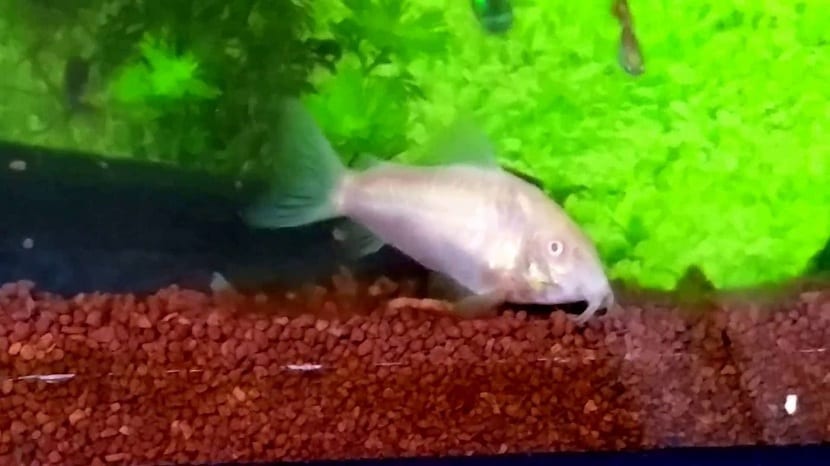
Now let's talk about the appearance of corydoras and their characteristics. Corydoras bring a particular beauty to the aquarium. The colors of these fish cannot be compared to that of other species or their swimming abilities. However, if we provide them with an aquarium where the conditions are right for them (have clean water, a neutral pH, low altitude and with good hiding places) we can see that corydoras are very beautiful fish. In addition, they have customs that make them more tame and funny.
To keep corydoras in good condition, you must add species that are compatible with them. These fish are very tough and hardy. Its physical structure counts with very hard bone plates to give them good protection and resistance, the one that is helped with the spiny rays of its dorsal and pectoral fins, which are very hard and sharp.
Thanks to the respiratory system that we have seen before, these fish have a great resistance to diseases. However, they can get sick like any other fish if the following conditions are met:
- When the fish is transported in large quantities from the fishermen's establishments to the wholesale warehouses. When this happens, their fins may be damaged. To cure them, it is best to put them in a fish tank in small quantities, clean water and medicated with an antiseptic. In this way they will avoid diseases.
- When they are exposed to intense environmental pollution. When there is too much organic waste that produces too much nitrites, they often suffer from bacterial conditions. The solution to this is to avoid having dirty water and renew it regularly.
Reproduction
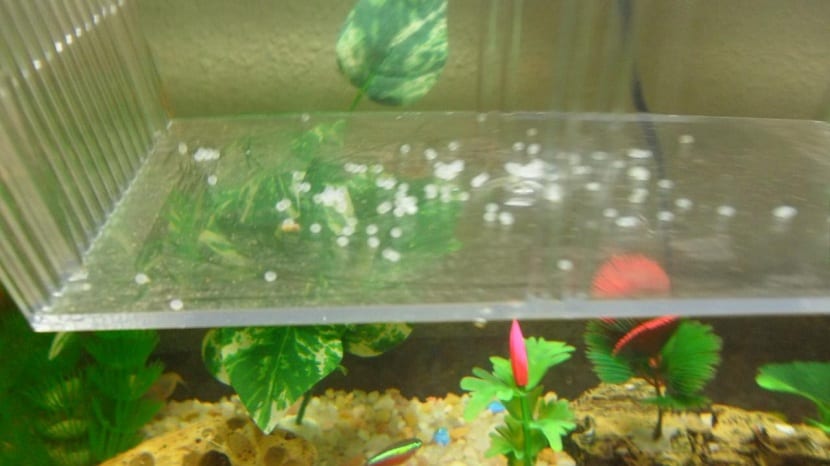
Corydoras have a particularly high demand for their reproduction. For example, corydoras paleatus they have an albino mutation that has been bred in captivity for many years.
This species will suffice with clean water, neutral pH and temperatures of 25-27 ° C. With this, between three to six males and one or two females will be able to produce spawning in the appropriate season.
For the young you must have a special aquarium, with dimensions of 120 × 45 cm and a height of 25 cm. without background filter.
With this information you will be able to learn more about corydoras when acquiring them and having them in your aquarium.